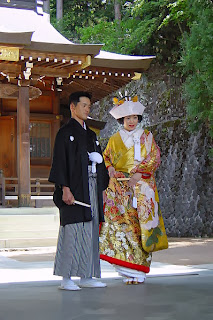▶ Japanese traditional costume 'Kimono'
The Japanese 'Kimono' is one of the world's instantly recognizable traditional garments. Originally worn to the bath house by the upper class and made of plain white cotton, 'Kimono' became popular among the common people. Today, brightly-colored 'Kimono' is common at summer festivals and fireworks displays, particularly for young women and children.
The kimono is a Japanese traditional garment. Kimono are T-shaped, straight-lined robes worn so that the hem falls to the ankle, with attached collars and long, wide sleeves. Kimono are wrapped around the body, always with the left side over the right (except when dressing the dead for burial.), and secured by a sash called an obi, which is tied at the back. Kimono are generally worn with traditional footwear and split-toe socks.
Today, kimono are most often worn by women, and on special occasions. Traditionally, unmarried women wore a style of kimono called furisode, with almost floor-length sleeves, on special occasions. A few older women and even fewer men still wear the kimono on a daily basis. Men wear the kimono most often at weddings, tea ceremonies, and other very special or very formal occasions. Professional sumo wrestlers are often seen in the kimono because they are required to wear traditional Japanese dress whenever appearing in public.
Women's Kimonos
Furisode are the most formal kimono for unmarried women, with colorful patterns that cover the entire garment. They are usually worn at coming-of-age ceremonies (seijin shiki) and by unmarried female relatives of the bride at weddings and wedding receptions.
Men's Kimonos
In contrast to women's kimono, men's kimono outfits are far simpler, typically consisting of five pieces, not including footwear.
Men's kimono sleeves are attached to the body of the kimono with no more than a few inches unattached at the bottom, unlike the women's style of very deep sleeves mostly unattached from the body of the kimono. Men's sleeves are less deep than women's kimono sleeves to accommodate the obi around the waist beneath them, whereas on a woman's kimono, the long, unattached bottom of the sleeve can hang over the obi without getting in the way.




댓글 없음:
댓글 쓰기